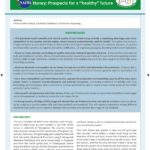
6 downloads
Title of document: Learning Brief- Marketing potential of Lao Forest Honey: Prospects for a “healthy” future_ English & Lao version Authors/editor: Emmanuelle Andaya, Soutsada Chanthasiri, Manivanh Aliyavong Journal’s name if any: Ministry/Government Agency/Organization: NAFRI, TABI, NUoL, GCDA, DECA, NTFP-EP Year of publication: 2018 Geographic focus: Lao PDR Main issues/ topics addressed (for example:…) School of agroecology (if any): Web address to original document (if any): Summary: NAFRI learning Brief: The perceived health benefits and natural quality of Lao Forest Honey provide a marketing advantage over other competitors in the country and the region, where honey is predominantly used for health. Strengthen Lao Honey’s image and brand as pure forest honey in the domestic and export markets through (1) a national standard, (2) quality and traceability systems, (3) hygiene and safety certification, (3) improved packaging, branding, and (4) communication. Focus on niche markets, competing on quality and value instead of quantity and price. Instead of the international bulk and traditional markets, the Lao Forest honey sector should focus on creating its own niche and capturing a share of the middle to high-end honey markets in the domestic and neighboring countries, and then expand to other high-value import ng countries. Increase domestic c consumption of Lao honey through accessibility and information dissemination. Improve distribution on systems and increase consumer awareness of the health benefits of honey in general, and the availability and quality of Lao honey to strengthen the domestic market. For a more competitive Lao Forest Honey Sector, upgrade the product and marketing capacity of the value chain actors, invest in research and development, and promote innovation. Combining traditional knowledge with new technology and techniques offers the potential to increase productivity and create unique honey products for health and other niche markets. Link up with entrepreneurs and other sectors. Make use of the tourism sector as a promoter on a platform and engage social entrepreneurs to further promote the Lao Honey Sector. A strong Country of Origin (COO) image will benefit the Lao Honey and other Lao natural products. Laos can develop its image as a country where safe and clean products are produced. This will require cooperation among different ministries and sectors and a national strategy that promotes and protects the image of Lao products. Read More
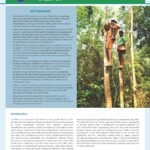
3 downloads
Title of document: NAFRI research Brief - Negotiating the Forest-Fallow Interface: Benzoin Tree in the Multifunctional Landscapes of Lao PDR Authors/editor: TABI Journal’s name if any: Ministry/Government Agency/Organization: NAFRI, TABI Year of publication: 2019 Geographic focus: Lao PDR Main issues/ topics addressed (for example:…) School of agroecology (if any): Web address to original document (if any): Summary: Research Brief No. 001/2019: Upland agriculture systems are under threat from competing land uses and development priorities that seek to intensify agricultural land uses while promoting strict forest conservation, leading to shortened fallow systems and a large-scale shift toward commodity crop production Better alternatives are needed for the development of Lao PDR’s uplands—alternatives that build on traditional management regimes, local agrobiodiversity and traditional knowledge systems rather than replace them, recognizing multiple uses of landscape systems and their substantial potential to contribute to sustainable socioeconomic development. Multifunctional landscapes depend on a complex mixture of croplands, forest, fallows and the diversity of endemic species used by local communities. Long-fallow rotational systems are a key element in these complex uplands, enhancing and supporting ecosystems services and the sustainability of upland systems Benzoin tree is exemplary of similar local species adapted to long-rotational cultivation systems and an integral part of upland diversity. Benzoin depends on long-fallowing and enhances economic returns from upland systems. Despite strong market demand and rising prices, Benzoin production has decreased dramatically in recent years due to shortening rotations and loss of available land due to forest conservation measures and the rapid expansion of commercial crops. Analysis indicates that for economic returns and production per unit of land and labour, benzoin production compares favourably with typical cash crop alternatives such as maize, while also delivering co-benefits for sustainability. Benzoin production represents an agro-forestry system with high sustainability. Benzoin should be regarded as an agricultural product, rather than a natural product with regard to quota systems and taxation. Read More

6 downloads
Title of document: NAFRI research Brief - New Directions for Participatory Land Use Planning: Can Bottom-up Approaches Achieve a Win-Win for Sustainable Development and Forest Conservation? Authors/editor: TABI Journal’s name if any: Ministry/Government Agency/Organization: NAFRI, DALaM, TABI Year of publication: 2019 Geographic focus: Lao PDR Main issues/ topics addressed (for example:…) School of agroecology (if any): Web address to original document (if any): Summary: Research Brief No. 002/2019: Land-intensive development pathways such as TLIC and the expansion of commercial agriculture are placing increased demand on rural landscapes and heightening tensions around resource-tenure security, requiring innovative approaches to planning. National development and conservation goals are sometimes, but not always, compatible with one another and with the needs and interest of local communities, requiring mechanisms for negotiation. Top-down planning tools provide a general framework for enhancing synergies and negotiating trade-offs between development and conservation goals at the macro-level, but bottom-up processes are necessary to ensure local needs and enable village-level planning and management. An innovative, bottom-up participatory land use planning approach co-developed and implemented by a consortium of GoL agencies, development practitioners and researchers through the Agro-biodiversity Initiative (TABI) demonstrates strong potential for supporting national development and conservation goals in a manner that is locally-acceptable and reflects actual land uses and resource needs. Through the participatory Forest and Land Use Planning and Management (pFALUPAM) approach, areas allocated for forests increased by 8.4 percent, though varied significantly by area depending on local contextual factors. Collaborative planning supported enhanced landscape-scale connectivity between forest areas, promoting ecosystem service values. Agrobiodiversity and the integrity of multifunctional landscapes were enhanced through zonation for local species and cultivars, protection of agricultural areas, and the promotion of long-fallowing in rotational upland systems through colocation. The pFALUPAM approach facilitated local management by clarifying inter-village boundaries to reduce conflict, enhancing local tenure security, and providing a mechanism for community consensus-building around management objectives. Further work is needed to support local institutions and capacities for adaptive management and the clarification of jap jong ti din1 and its effects on communally-managed resources. Read More
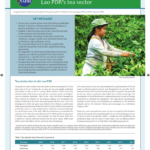
15 downloads
Title of document: NAFRI Policy Brief - Unlocking the full potential of Lao PDR’s tea sector_English & Lao version Authors/editor: Sengphachanh Sonethavixay, Khamphou Phouyyavong (PhD Candidate), Phanxay Ingxay (PhD), Isabelle Vagneron (PhD) Journal’s name if any: Ministry/Government Agency/Organization: NAFRI Year of publication: 2018 Geographic focus: Lao PDR Main issues/ topics addressed (for example:…) School of agroecology (if any): Web address to original document (if any): Summary: Policy Brief No. 001/2018: Tea in Laos is mainly grown and collected by smallholder farmers. It thus has a strong potential to contribute to poverty alleviation and rural development. Despite a relatively large production area, the volumes of tea produced and exported are low. Laos could take advantage of favorable production conditions, unique varieties and traditional know-how to develop a high-quality tea sector. The most pressing issue is to improve quality both inside the tea garden and at later stages (harvesting, processing). It is important to note however that improving farmer capacity can only be successful if the value-chain is organized in a way that farmers are able to reap the benefi ts of their eff orts towards improved quality. A sustainable and inclusive tea sector strategy focusing on the livelihoods and benefi ts of smallholder farmers, fair trade practices, building up and/or upgrading local processing facilities and diversifi ed markets should be collectively defi ned. Read More

73 downloads
Title of document: National Action Plan for Sustainable Rattan and Bamboo (2020-2025) Authors/editor: GRET, MAF, WWF, SDC Journal’s name if any: Ministry/Government Agency/Organization: GRET, MAF, WWF, SDC Year of publication: 2021 Geographic focus: Lao PDR Main issues/ topics addressed (for example: …) School of agroecology (if any): Web address to original document (if any): Summary: Lao PDR is endowed with biodiversity and rattan and bamboo species that have played an important role in generating income for the rural communities. It was estimated that rattan and bamboo can contribute about 22,000,000 US dollars or more per year to the country's Gross Domestic Product (GDP) with about 150,000 households, within 1,700 villages, have access to and use rattan-bamboo resources. Many stakeholders agreed that the rattan-bamboo sectors still have a high potential for sustainable development based on the experiences and lessons learned from many projects that have been implemented in the past, such as the Bamboo and Rattan Project (GRET) and the Sustainable Rattan and Bamboo Harvesting Project (WWF). In Lao PDR, the sector’s development is still very scattered without a specific action plan to support it. This has resulted in the limited effectiveness of resource management for rattan and bamboo. The development of rattan and bamboo value chains and their contribution to income generation and poverty reduction can be improved. Read More
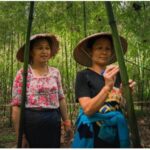
77 downloads
Title of document: Managing our natural resources for a better life in the villages of Houaphanh Province: Six Briefs on Bamboo Forest Management and Value Chains Development Authors/editor: Gret, BNDA Journal’s name if any: Ministry/Government Agency/Organization: Gret, BNDA Year of publication: 2020 Geographic focus: Lao PDR Main issues/ topics addressed (for example: …) School of agroecology (if any): Web address to original document (if any): Summary: Huaphan Province is diversity of natural bamboo forest. Recognizing this potential since 2009, GRET through its Bamboo and Rattan project with the Houaphanh government and its Bamboo Taskforce has been supporting the Huaphan Bamboo Sector Development Strategy 2011-2015 & 2016 -2020. 5 bamboo value chains being actively developed within the province and supported by the Bamboo and Rattan Project are 1) Handicraft Value Chain; 2) Mai Khuane Value Chain; 3) Khom (Bamboo Shoot) Value Chain; 4) Broom Grass Value Chain; and 5)Red Mushroom Value Chain... After the project has ended, the Bamboo and NTFPs Development Association (BNDA) will continue to support it. You can view BNDA activities via the Facebook page: “ສະມາຄົມພັດທະນາໄມ້ປ່ອງ&ເຄື່ອງປ່າຂອງດົງ/Bamboo & NTFP Development Association” or by email: bnda2018@gmial.com Read More

45 downloads
Title of document: The Lao Coffee Notebook Authors/editor: RURAS and Comma Coffee Journal’s name if any: Ministry/Government Agency/Organization: RURAS and Comma Coffee Year of publication: 2020 Geographic focus: Lao Main issues/ topics addressed (for example: Coffee Production, processing roasting and brewing, including a map, statistics…) School of agroecology (if any): Web address to original document (if any): https://laocoffee.org/2020/10/03/lao-coffee-notebook/ Summary: The Lao Coffee Notebook is now available! Produced by LURAS in cooperation with Comma Coffee, this unique notebook is packed with information about coffee production, processing roasting and brewing, including a map, statistics and a Lao-English wordlist, all of which has been beautifully illustrated by Tina at Helvetas. Read More

55 downloads
Title of document: Non-Timber Forest Products in the Green Economy of Lao PDR Authors/editor: Micah L Ingalls, Phetsaphone Thanasack, Cornelia Hett, Andreas Heinimann, Khamphou Phyoyyavong Journal’s name if any: Ministry/Government Agency/Organisation: TABI Year of publication: 2020 Geographic focus: Lao PDR Main issues/ topics addressed (for example: …) School of agroecology (if any): Web address to original document (if any): https://www.researchgate.net/publication/339301368_Non-Timber_Forest_Products_in_the_Green_Economy_of_Lao_PDR?fbclid=IwAR1zZxZOTIfXR-kecPZYrrPrJKe6n1fsvBwFQxe7O-OidjTs80dge1Ile_A Summary: Poster from The Agrobiodiversity Initiative Project which underlines the importance of Non Timber Forest Products (NTFP) for upland families in Laos. Read More
52 downloads
Title of document: Natural succession in Syntropic farming Authors/editor: Life in Syntropy Journal’s name if any: Ministry/Government Agency/Organisation: Life in Syntropy Year of publication: Geographic focus: General Main issues / topics addressed (for example:…) School of agroecology (if any): Web address to original document (if any): Summary: Read More
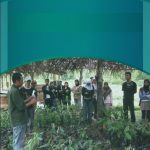
364 downloads
Title of document: Permaculture Handbooks by IDEP Foundation Authors/editor: IDEP Foundation with PERMATIL and GreenHand Journal’s name if any: Ministry/Government Agency/Organisation: IDEP Foundation with PERMATIL and GreenHand Year of publication: 2011 Geographic focus: Indonesia Main issues / topics addressed (for example:…) School of agroecology (if any): Web address to original document (if any): Summary: To provide a wide range of practical and comprehensive guidelines, tools, and techniques for delivering effective Permaculture workshops. It includes over 200 presentations, creative thinking exercises, and practical hands-on exercises which can be used by local facilitators to design and implement effective courses appropriate to the needs in their area. It has been designed to work in conjunction with the companion books “A Resource Book for Permaculture - Solutions for Sustainable Lifestyles” and “The Permaculture Facilitator’s Handbook for Training and Assessment.” The workshop techniques include knowledge and practical techniques for environmental rehabilitation and sustainability, strengthening community resilience and local economies. The contents of the book are based on concepts of deep ecology, the inter connectedness of our environment and culture and the principles and ethics of sustainable community development. Read More

 Asia & Mekong Region
Asia & Mekong Region  Cambodia
Cambodia  Laos
Laos  Myanmar
Myanmar  Other
Other  Vietnam
Vietnam